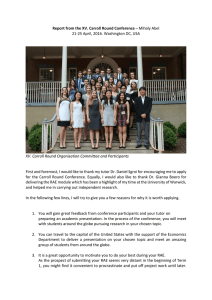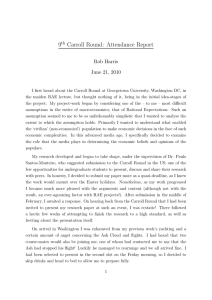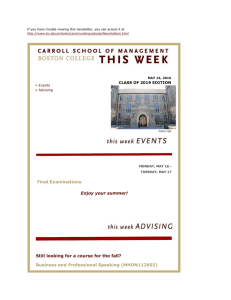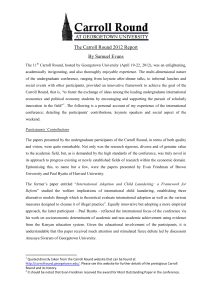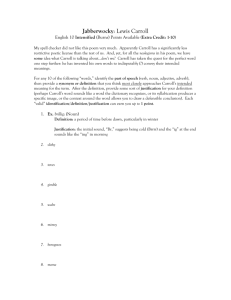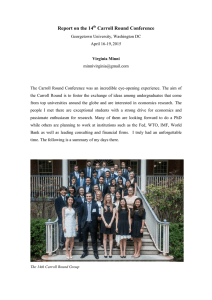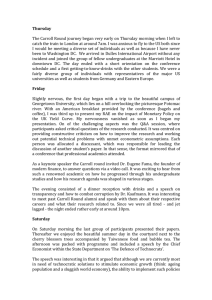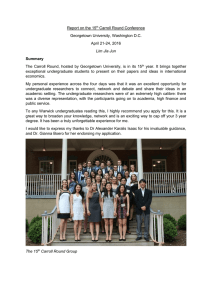F A C R
advertisement
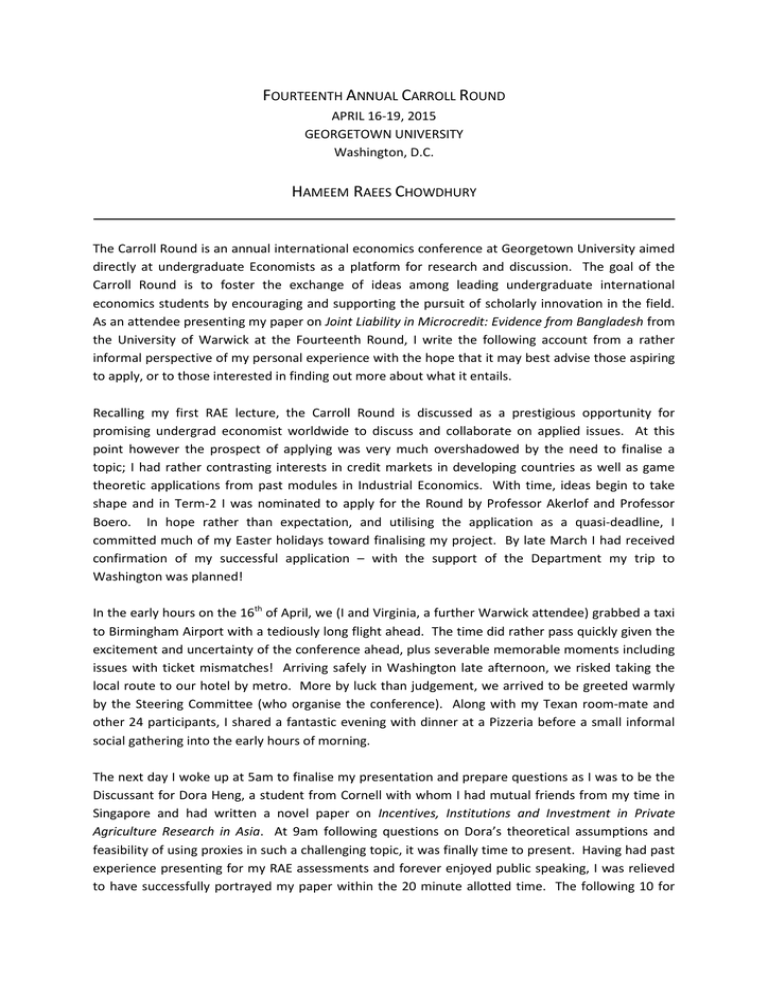
FOURTEENTH ANNUAL CARROLL ROUND APRIL 16-19, 2015 GEORGETOWN UNIVERSITY Washington, D.C. HAMEEM RAEES CHOWDHURY The Carroll Round is an annual international economics conference at Georgetown University aimed directly at undergraduate Economists as a platform for research and discussion. The goal of the Carroll Round is to foster the exchange of ideas among leading undergraduate international economics students by encouraging and supporting the pursuit of scholarly innovation in the field. As an attendee presenting my paper on Joint Liability in Microcredit: Evidence from Bangladesh from the University of Warwick at the Fourteenth Round, I write the following account from a rather informal perspective of my personal experience with the hope that it may best advise those aspiring to apply, or to those interested in finding out more about what it entails. Recalling my first RAE lecture, the Carroll Round is discussed as a prestigious opportunity for promising undergrad economist worldwide to discuss and collaborate on applied issues. At this point however the prospect of applying was very much overshadowed by the need to finalise a topic; I had rather contrasting interests in credit markets in developing countries as well as game theoretic applications from past modules in Industrial Economics. With time, ideas begin to take shape and in Term-2 I was nominated to apply for the Round by Professor Akerlof and Professor Boero. In hope rather than expectation, and utilising the application as a quasi-deadline, I committed much of my Easter holidays toward finalising my project. By late March I had received confirmation of my successful application – with the support of the Department my trip to Washington was planned! In the early hours on the 16th of April, we (I and Virginia, a further Warwick attendee) grabbed a taxi to Birmingham Airport with a tediously long flight ahead. The time did rather pass quickly given the excitement and uncertainty of the conference ahead, plus severable memorable moments including issues with ticket mismatches! Arriving safely in Washington late afternoon, we risked taking the local route to our hotel by metro. More by luck than judgement, we arrived to be greeted warmly by the Steering Committee (who organise the conference). Along with my Texan room-mate and other 24 participants, I shared a fantastic evening with dinner at a Pizzeria before a small informal social gathering into the early hours of morning. The next day I woke up at 5am to finalise my presentation and prepare questions as I was to be the Discussant for Dora Heng, a student from Cornell with whom I had mutual friends from my time in Singapore and had written a novel paper on Incentives, Institutions and Investment in Private Agriculture Research in Asia. At 9am following questions on Dora’s theoretical assumptions and feasibility of using proxies in such a challenging topic, it was finally time to present. Having had past experience presenting for my RAE assessments and forever enjoyed public speaking, I was relieved to have successfully portrayed my paper within the 20 minute allotted time. The following 10 for Q&A were then priceless with regards to offering new insights and further empirical tactics to strengthen my results. Levi Boxell, my discussant also had a keen interest in my area of credit market Development Economics, to whom I am indebted for the advice I then took on when submitting my final RAE. Relieved of pressure, the rest of the day included a dinner at Mai Thai in central Washington, the obligatory Carroll Round Group Photo as well as attending and discussing presentations, of which I particularly enjoyed Adjusting for Overconfidence using Partition Dependence by Geeva Gopalkrishnan and Capital Requirements and Post-Crisis Monetary Policy Tranmission by Thomas Christiansen. Post-presentations were also a Policy Simulation based loosely on the Narmada Dam in India, for which we were allocated into different groups representing for example farmers and government to decide on policy implications. The result: we very much confirmed that individuals are self interested. Later in the evening we attended a formal soiree on the rooftops of D.C. alongside Alumni from previous Carroll Rounds. This was one of the highlights of my trip as along with the views it was truly rewarding to evidently be amongst those from such contrasting backgrounds that had a common interest in Economics yet otherwise showed such potential in other fields such as mechanical engineering and medicine. Over dinner I was fortunate to be next to Mariana, a Brazilian alumni from the Third Carroll Round with whom I shared a common sense of humour and development economics interest. The keynote speaker for the evening, Dr Rajiv Shah, the administrator of US AID then delivered an enlightening speech which trigger the discussion of whether AID is sustainable and a solution to long run poverty (I may have been the one to ignite the debate). Wishing to seize all of my time at D.C., I then headed out with my roommate and the local Georgetown students for the evening. The following day was sweltering in temperature; given transport issues I volunteered to walk to the campus with a student from Vassar College, Lea. After a further morning of presentations with short breaks taking in the sun outside, we visited the McGhee Library during lunch. Further presentations followed of which Trade Liberalisation and Deforestation by Emily Reeves with whom I became close friends was inspiring, and my roommate Michael Lee’s Agent Based Model for Competitive Equilibrium which utilised software he himself had created to best predict locations for oil and electricity plants. Also to exemplify the standard, Raphael Small’s Dynamic Link between Inequality and Economics Growth showcased econometric software he himself had built that incorporated bulk data such that the algorithms take 9-days to run. Next up, a keynote speech by Dr George Akerlof – with my supervisor being Dr Robert Akerlof, as you can imagine this was a very big deal for me! Presenting his paper on Phishing for Phools showcased the brilliance of his thinking, and using novel examples such as monkeys and cinnamon rolls made the ideas accessible and relatable, ideas that I aspire to take on myself in future presentations. After a short Q&A, I greeted Dr Akerlof only to be told that he had been expecting to meet me as Robbie had told him prior! This was certainly a memory to keep, alongside the obligatory photo with him and Virginia. To end the evening we gathered now as a tight-knit group of participants in the lobby, chattering away as we headed to dinner to tick off eating American Burgers by the river. Following this was an organised bowling social, which was overshadowed by the secret-notso-secret social at a committee member’s house (this may have also been because I had an off day bowling). The morning after, exhausted and lacking sleep for one reason or another, I headed one last time to Georgetown to attend the Presentation of Awards and closing speeches. Hearing from Dean Kanada and founders of the very first Carroll Round over breakfast made the ending ever more difficult. Finally after congratulating the committee on their hard work, the awards began for which I was honoured to achieve “Outstanding Participation” for my Presentation and leading of Discussions for which I was deemed to have ‘embodied what the Carroll Round objectifies’. After my short speech congratulating the committee for their successes in running the conference, we shared our goodbyes and contact details before receiving memorabilia and a book of published Carroll Round papers (our papers are to be published the following year). With our evening flight home looming amongst our RAE deadline of course, I decided nonetheless to head into Washington with fellow participants Emily, Thomas and Michael; quickly taking in the sights including the Lincoln Memorial, World War Two Memorial and White House amongst others. One by one we then headed our separate ways from the hotel lobby, leaving me and Virginia to reminisce on our past few days in Washington. The trip home was sentimental and also involved frantically upgrading our RAE’s with our new found advice prior to the deadline! I wholeheartedly advise those of you passionate about economics to seize the opportunity to apply to the Carroll Round. The level of participants at the conference only further motivate and push you towards bettering yourself and your work; the experience is invaluable and leaves lasting memories of my time at Warwick as I graduate in the near future. The teachings at the Warwick Economics Department are to a standard is second to none; your knowledge in Economics is both broad and complete. It is how you choose to apply that knowledge that defines you however, and the Carroll Round is the pinnacle of such an example. From a more personal level the people I have become close to shall stay with me in time; my roommate Michael and I share an interest in entrepreneurship and prospectively look to working on a start-up together; in Emily, Thomas and Lea amongst other I know I always have a place in the US. And yet this remains only a short summary of my time at Washington; the lasting memories are endless. Acknowledgement I am indebted to Dr. Robert Akerlof for his support and comments as supervisor, Dr. Jeremy Smith for his knowledge on empirical techniques, Dr. Md. Kayes Samim Polash of Proshikar with whom I conducted the field experiments, Dr. Robert Akerlof and Dr. Gianna Boero for nominating this paper for the Carroll Round (for which it earned Outstanding Participation) and British Conference of Undergraduate Research, Mr. Shakhawat Hossain of Jai Jai Din for bringing media attention to my field work, and numerous others.
